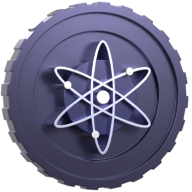- Moniker: OWALLET
- Validator address: cosmosvaloper19qv67gvevp4xw64kmhd6ff6ta2l2ywgfm74xtz
- Seed: [email protected]:10001
- Software version: v21.0.0
- RPC: https://cosmos-rpc.owallet.io
- LCD: https://cosmos-rest.owallet.io
- GRPC: osmosis-grpc.owallet.io:9999
Describle
Cosmos is a decentralized network of independent blockchains designed to create an "internet of blockchains," where each chain can interact with others in a seamless, scalable, and secure manner. Its goal is to solve some of the most pressing problems in blockchain technology, such as interoperability, scalability, and usability. Below are the key features of the Cosmos Network:
- Cosmos enables different blockchains to communicate and transfer assets or data between one another through its IBC protocol.
- This interoperability allows for the creation of a decentralized network of blockchains, where each blockchain can maintain sovereignty but still collaborate with others.
- At the heart of Cosmos is Tendermint, a Byzantine Fault Tolerant (BFT) consensus engine that allows for fast finality and high throughput.
- Tendermint provides a robust and secure proof-of-stake (PoS) consensus algorithm, making it easier to build scalable and secure blockchain applications.
- The Cosmos SDK is a modular, open-source framework that allows developers to easily build custom, secure, and scalable blockchains.
- Developers can pick and choose the modules they need, allowing for faster blockchain development with pre-built consensus, staking, governance, and other functionality.
- The native token of Cosmos is ATOM, which is used for staking, securing the network, and participating in governance.
- Validators and delegators in the network use ATOM to vote on protocol upgrades and changes, ensuring decentralized governance.
- Cosmos uses a unique hub-and-zone architecture to connect various blockchains. The Cosmos Hub is the first blockchain on the network, and it connects to other blockchains (called "zones") via IBC.
- Each zone is an independent blockchain that can specialize in different use cases (e.g., DeFi, NFTs, etc.) and still transfer assets and data through the Cosmos Hub.
- Cosmos solves scalability issues by enabling multiple parallel blockchains (zones), each tailored for a specific use case.
- Instead of one monolithic blockchain processing everything, Cosmos scales horizontally by allowing many blockchains to run concurrently, each optimized for different purposes.
- Cosmos uses a proof-of-stake (PoS) consensus mechanism, where validators stake ATOM tokens to validate transactions and secure the network.
- Validators are incentivized to behave honestly, as they can lose their staked ATOM if they act maliciously (via slashing).
- Cosmos uses an on-chain governance system where ATOM holders can vote on proposals for protocol upgrades, changes, and decisions affecting the network's future direction.
- This makes Cosmos a self-evolving system, where the community can make decisions democratically.
- Cosmos aims to simplify the blockchain development process by providing developers with tools like Tendermint and the Cosmos SDK.
- Developers can build sovereign blockchains or connect existing ones to the Cosmos ecosystem without complex bridges or intermediaries.
- Cosmos has been adopted by a wide range of projects, including Binance Chain, Terra, Osmosis, and others, all of which leverage Cosmos' technology for scalability and interoperability.
Cosmos is a rapidly growing network designed to foster a decentralized, scalable, and interoperable blockchain ecosystem. By addressing key limitations in blockchain technology—like scalability, usability, and the ability to interoperate across different chains—Cosmos is helping to advance the entire decentralized ecosystem.
